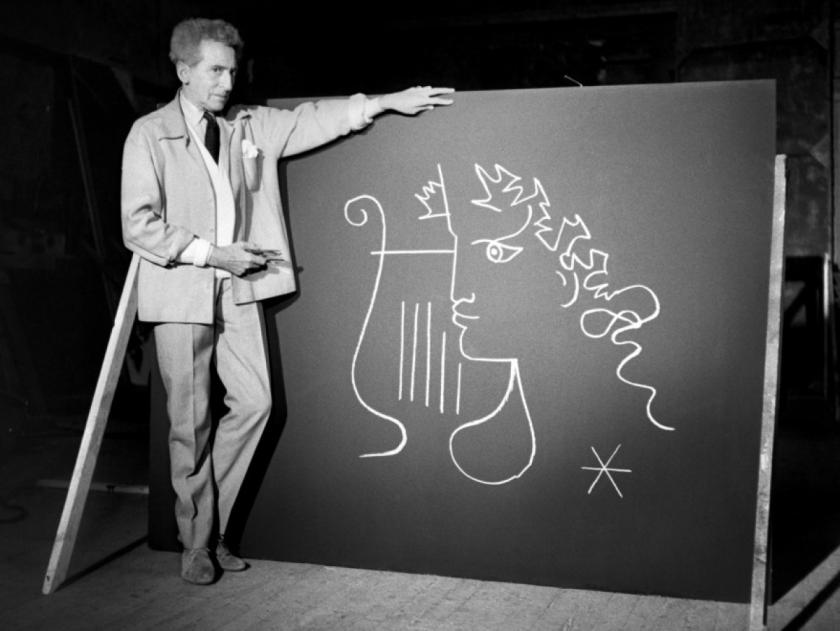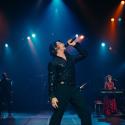Jean Cocteau, who died 50 years ago today, was a poet/novelist /playwright /film director/designer/painter/stage director/ballet producer/patron/myth-maker/friend of the great/raconteur/wit. A Jacques of all trades and master of all. “Etonne-moi!” (“Astonish me!”) were the words with which Sergei Diaghilev, founder of the Ballets Russes, challenged Cocteau. The result was the ballet Parade (1917), designed by Pablo Picasso, composed by Erik Satie, and set to a scenario by Cocteau. The latter continued to astonish ever after.
It is difficult to isolate the films Cocteau directed and/or wrote from his work in other art forms (Londoners can compare his magnificent murals at the Notre Dame de France church off Leicester Square.) Films were just another form of poetry, and the poet at the centre of his oeuvre, ie himself.
Beauty is slightly disappointed when the Beast turns into his young, romantic self
Cocteau made his first film when he was 41 and already famous. The Blood of a Poet (1930) contains all the signs and symbols of the personal mythology evident from his poems, novels, plays and drawings. The death and resurrection of a poet (Orpheus), the link between death and youth (beautiful young men), tauromachy, living statues, opium (of which he was a constant user) and the passing to the other side of the mirror.
Thanks to the patronage of the Vicomte de Noailles, Cocteau was free to experiment with film, exploring the creative process in arresting dream-like images. Although surrealist in manner, The Blood of a Poet (see clip below) was too calculated and conscious to be considered as such by André Breton, surrealist supreme, though Cocteau wrote: "It is often said that The Blood of a Poet is a surrealist film. However, Surrealism did not exist when I first thought of it." The film was a great influence on the American avant-garde, particularly on Kenneth Anger.
Orpheus (1950) is a perfect marriage of Greek myth and Cocteau’s own, and although it uses reverse slow-motion and negative images to suggest the Underworld (reached through the looking glass), the modern-day domestic life of Mr and Mrs Orpheus is filmed “realistically”, elaborating the theme of the poet caught between the worlds of the real and the imagination. “You've never seen death?” says the angel Heurtebise (François Périer). “Look in the mirror every day and you will see it like bees working in a glass hive.”
In Beauty and the Beast (1945, pictured below right), a fairy tale for children and intelligent adults, Cocteau stated that he discouraged his cinematographer, Henri Alekan, and the brilliant art director Christian Bérard from virtuosity in order to show “unreality in realistic terms”. Thankfully virtuosity is evident everywhere in the magical scenes in Beast’s castle. The beast is played touchingly by Jean Marais, behind extraordinary makeup. In the end Beauty is slightly disappointed when he turns into his young, romantic self. Marais, Cocteau’s primo uomo and one-time lover, whose profile Cocteau used for his drawings of Greek heroes, starred in all the films that Cocteau directed or wrote, with the exception of The Blood of a Poet.
 The Eagle Has Two Heads (1947) and Les parents terribles (1948) were clever transpositions of Cocteau’s plays to the screen. However, though his cinematic sense prevented them from looking stagey, these wordy and overripe melodramas were happier behind a proscenium arch. Nevertheless, the use of close-ups enabled the director "to catch my wild beasts unawares with my tele-lens".
The Eagle Has Two Heads (1947) and Les parents terribles (1948) were clever transpositions of Cocteau’s plays to the screen. However, though his cinematic sense prevented them from looking stagey, these wordy and overripe melodramas were happier behind a proscenium arch. Nevertheless, the use of close-ups enabled the director "to catch my wild beasts unawares with my tele-lens".
Although directed by others, Cocteau’s presence is strongly felt in other adaptations of his works. Les enfants terribles (Jean-Pierre Melville, 1950), based on his claustrophobic 1929 novel of sibling love, was shot entirely on the stage of the Théâtre Pigalle. Melville’s severe style and craftsmanship, combined with the bejewelled prose, retained much of the strange atmosphere of the original. Roberto Rossellini directed Anna Magnani in a film version of Cocteau’s monodrama La voix humaine (The Human Voice, 1948), and Jacques Demy shot Le bel indifférent (1957) from the 1940 one-act play, written for and starring Édith Piaf (coincidentally, Piaf died on the same day as Cocteau.)
L’éternal retour (Jean Delannoy, 1943) – Cocteau's original screenplay, updating the Tristan and Iseult legend – had two lovers (Marais and Madeleine Sologne) falling hopelessly in love as a result of a love potion issued to them by a vicious dwarf, and eventually finding their apotheosis in death. There is something a trifle ludicrous about the liebestod in the context of "modern youth" in ski jerseys, apparel that became fashionable because of the film’s huge success in France. Made during the Occupation, its blond Aryan lovers were extremely pleasing to the occupiers.
 Cocteau’s attitude to the Nazis can be described generously as ambivalent. He fraternised with Germans and was an admirer and friend of Hitler’s favourite architect Arno Breker. This helped him to have his plays and films produced, although much of his art was considered decadent, and he was known to be homosexual. However, Cocteau did all he could to save Max Jacob, the Jewish-born Catholic convert writer, from being sent to a concentration camp, to no avail.
Cocteau’s attitude to the Nazis can be described generously as ambivalent. He fraternised with Germans and was an admirer and friend of Hitler’s favourite architect Arno Breker. This helped him to have his plays and films produced, although much of his art was considered decadent, and he was known to be homosexual. However, Cocteau did all he could to save Max Jacob, the Jewish-born Catholic convert writer, from being sent to a concentration camp, to no avail.
The third of Cocteau's Orphic trilogy, The Testament of Orpheus, his valedictory film, is a self-indulgent, self-mocking self-portrait, with references to his other films, writings and life. He himself wanders through the film (pictured above left), his feet hardly touching the ground, explaining his art with the help of friends (Picasso, Yul Brynner, Marais, Édouard Dermithe, his adopted son, etc.) But, as Cocteau commented, "a film, whatever it may be, is always its director’s portrait." Here, he is penetrated by a sword, but pops up from his grave uttering the words: "A poet can never die." Cocteau’s body died in October 11,1963, but his art lives on.















Add comment